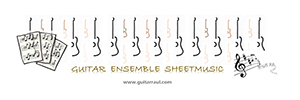O. Timofeyev / M. Bazzotti,
https://www.academia.edu/37684
Excerpt from an article by O. Timofeyev and M. Bazzotti, published in the issue no. 103 of the Italian quarterly “il Fronimo”: excerpt version with limited musical examples. Publication Date: Dec 1998 Publication Name: Just Classical Guitar, 1999
When we are listening to music (say, an ensemble or several different instruments and/or voices), and suddenly there comes a strummed guitar chord — just the luxuriant tone quality of it immediately pushes the invisible “Hispanic button” within our receptive mechanism. We habitually and justly associate guitars with Spain (or Latin America), since so much delightful guitar-playing came and still comes from those warm areas. For the cold Russia, on the other hand, another plucked instrument is traditionally reserved — the triangular balalaika whose uneven shivering tremolo does not fail to push the “Russian button.” Film directors use this sound effect over and over when they need to bring out a Russian theme in their soundtracks.
But very few people realize the magnitude and wealth of the early-19th-century Russian guitar repertoire, mainly associated with the instrument whose seven strings are tuned to the pitches of the G major chord. (Note 1: Those who read Il Fronimo regularly will remember a substantial article by Matanya Ophee in the no. 58 (1987), one of the first works introducing the Russian guitar tradition to the Western audience.)During the first half of the 19th century, a number of first-rate composers wrote music for the Russian guitar, and the instrument itself was depicted in numerous paintings, literary texts and personal memoires. Toward the end of the century the guitar apparently migrated down the society hierarchy, becoming mainly the instrument of the poorer classes and gypsies. (Note 2: There must have been some real virtuosi among such performers, no doubt. Yet, we prefer to focus on the music of the earlier period, since so much of it survives in the libraries.)By the mid-century, in his first attempt to write a history of the seven-string guitar, Mikhail Stakhovich addresses the guitar
tradition with an air of nostalgia





